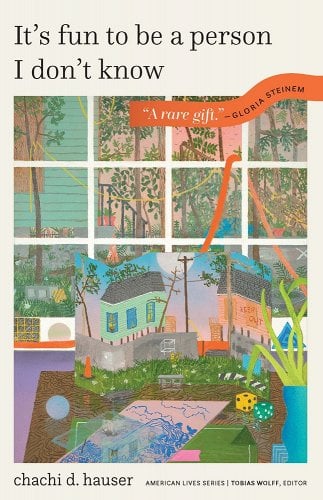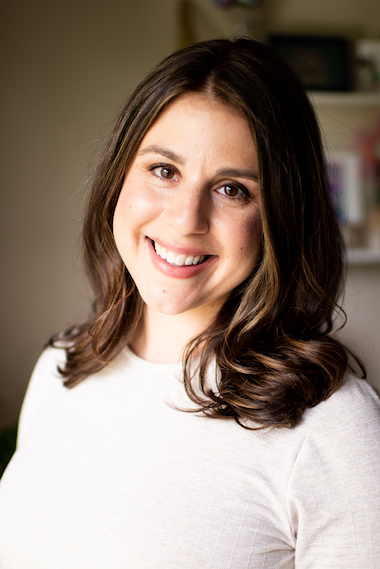Reviewed by Layla Khoury-Hanold
It’s Fun to Be a Person I Don’t Know (University of Nebraska Press; March 2023) is part of the American Lives Series, which “features works of creative or literary memoir that, whether evoking moments of death or disease, in family or marriage, history, politics, religion, or culture, provide glimpses into singular American lives.” It’s easy to see why Chachi D. Hauser’s literary memoir fits the bill—and not only because her middle initial stands for a famous last name (more on that later).
From the outset, I was taken by the lyrical, poetic quality of Hauser’s voice. There’s an earnestness about it, suffused with a sensuousness of both language and of self, and it makes the reader want to follow wherever it leads. The author’s next feat of creativity i s the book’s structure: It is a marvel. Each chapter is constructed of short snippets that effortlessly traverse timelines and places without leaving the reader unmoored. Hauser deftly braids personal history and the complicated legacy of inheriting the Disney name (which she cloaks by using only D as part of her initials). Early in the book, she expresses that she already knows the limitations of fame. “But fame cannot be worn again by descendants like a hand-me-down, passed down through the generations; the wearer will always change its meaning.”
s the book’s structure: It is a marvel. Each chapter is constructed of short snippets that effortlessly traverse timelines and places without leaving the reader unmoored. Hauser deftly braids personal history and the complicated legacy of inheriting the Disney name (which she cloaks by using only D as part of her initials). Early in the book, she expresses that she already knows the limitations of fame. “But fame cannot be worn again by descendants like a hand-me-down, passed down through the generations; the wearer will always change its meaning.”
Perhaps this sentiment frees the author to do the work of interpreting and deriving new meaning. In revisiting her childhood and focusing on the tangible—Disney theme park rides, storylines, title songs, merchandise—she explores a cultural commentary that unflinchingly holds up a magnifying glass to topics such as gender constructs, gender inequality, racism, antisemitism, and indigenous rights, examining how her ancestors oppressed others in the name of making art. It is, at times, as if Hauser is looking at their own life like a rollercoaster ride and dissecting it, appraising the animatronics, wondering which characters and symbols were chosen from certain stories and why? Is it really a quest to present an accurate representation or a bid to distort the truth? What do these symbols really represent? When there is a malfunction on the ride, be it an actual Disney World ride or the roller coaster of life, she probes deeper to examine what contributed to their failing. Hauser asks the reader to consider: How hard must one work to continue illuminating the fantasy and push reality to the shadows?
As a documentary film maker, Hauser wants to make her own art, but knows she wants it to be different from the way Disney did it. Within her longing to make art that better reflects the human experience, and her own lived experience, Hauser also seeks to define the truth about herself by examining who she came from, where she’s been, and where she’s going. Hauser states it succinctly: “I want to create myself, a person who recognizes their lineage but is not defined by it.” The crux of the book, within the broader construct of Disney, is the narrative thread of her own life and how she navigates it within her own fluid identity, questioning what it means to be female, male, or non-binary; how she wants to be perceived in the context of a romantic relationship; and how to define the edges within the fluctuating boundaries of an open relationship. “The truth is, I don’t know what I am. I don’t want to have to pick, one or the other—I want to float, to exist in the in-between, inside the world of unpredictability,” she writes. Concluding the passage with “I don’t know what I want, or who I want, and this not-knowing is my only stability.”
Throughout the book, the reader is given the gift of being able to access the author’s interiority, where contradictions, challenges, and, at moments, celebrations reside. In writing this book, perhaps the author has given herself a gift, too. In one passage, Hauser shares that writing, as well as drawing, allows her “the freedom to become simply a voice, unattached from expectations of the way I dress, the way I talk, the way I am inside my gendered body. With drawing, with writing, I could uncover myself, the person I longed to be.” It makes the reader consider what might be hidden within them, and whether they have the curiosity and courage to peel back the layers to unveil their own yearning.
It’s Fun to Be a Person I Don’t Know is a slim tome, but we know by now not to judge a book by its cover. To do so would bely the rich, deep textures and intricately woven narratives that the reader gets to unravel and the gorgeous writing to be deliciously savored. In revealing so much of the author’s lived experience, we as readers are invited to imagine what our own narrative might sound like, rather than parroting the one we, or others, tell ourselves is true. Maybe part of the fun, as Hauser suggests, is not knowing.
 Layla Khoury-Hanold is a freelance journalist who has written for Food52, Food Network, and the Chicago Tribune, among others. She is currently working on her debut memoir. Follow her on Instagram @words_with_layla or on Twitter @words_withlayla.
Layla Khoury-Hanold is a freelance journalist who has written for Food52, Food Network, and the Chicago Tribune, among others. She is currently working on her debut memoir. Follow her on Instagram @words_with_layla or on Twitter @words_withlayla.


